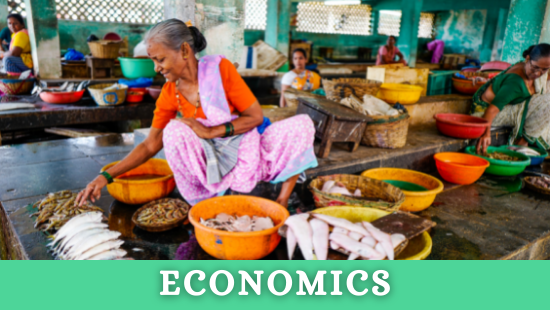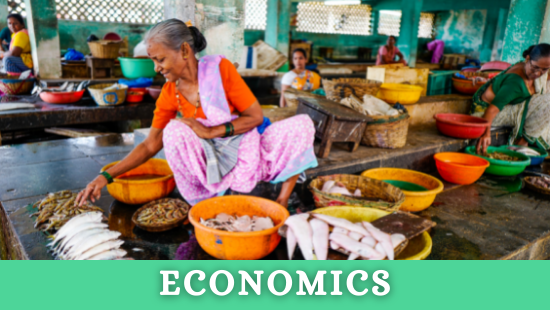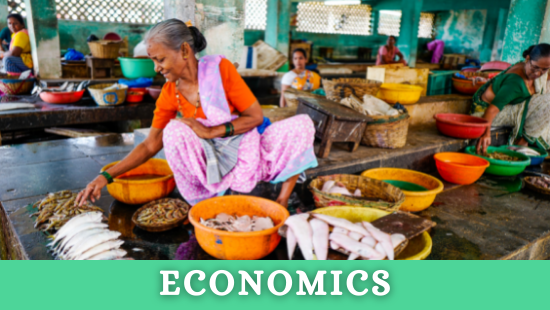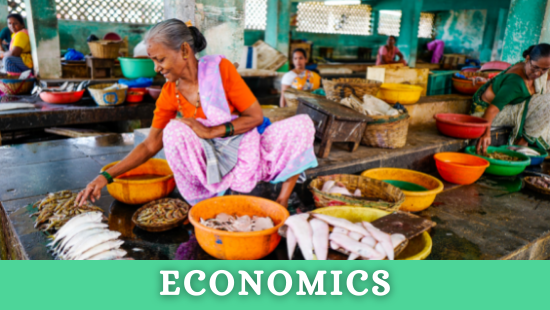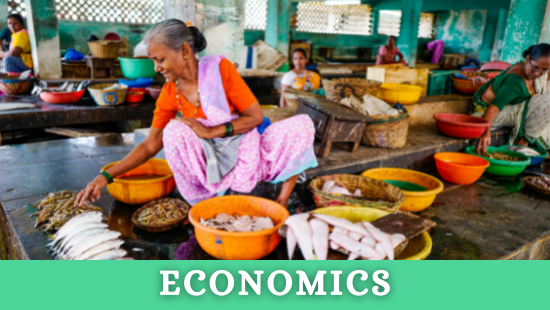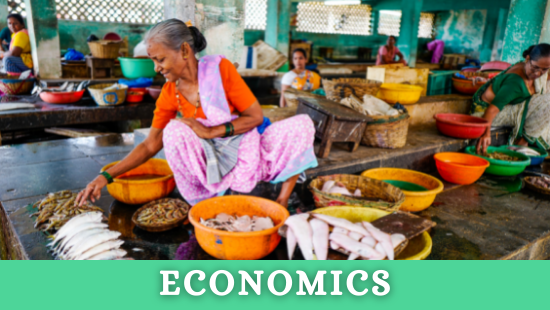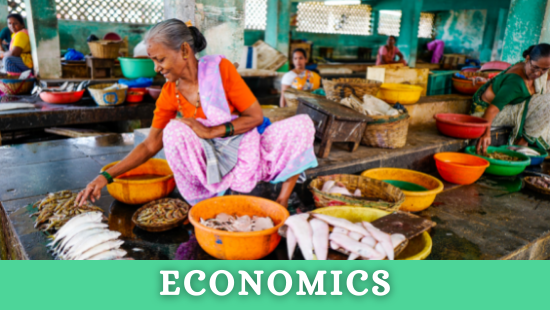
CBSE Class 10 Economics Chapter 1 Development Notes and Exercise Question & Answer
Language: en
LRNR Classes
Class 10 – Economics
Chapter 1 – Development
1. Development of a country can generally be determined by
- it is per capita income
- its average literacy level
- health status of its people
- all the above
Answer: d. all the above
2. Which of the following neighbouring countries has better performance in terms of human development than India?
- Bangladesh
- Sri Lanka
- Nepal
- Pakistan
Answer: b. Sri Lanka
3. Assume there are four families in a country. The average per capita income of these families is Rs 5000. If the income of three families is Rs 4000, Rs 7000 and Rs 3000 respectively, what is the income of the fourth family?
- Rs 7500
- Rs 3000
- Rs 2000
- Rs 6000
Answer: d. Rs 6000
(4000+7000+3000+x) ÷ 4 = 5000
14000+x = 5000 × 4
x = 20000-14000
x = 6000
4. What is the main criterion used by the World Bank in classifying different countries? What are the limitations of this criterion, if any?
Answer: World Bank uses the per capita income to classify different countries. The per capita income is calculated by dividing the total income of the country by the population of the country. For the year 2017, the countries with per capita income of US $12,056 per annum were declared rich countries and the countries with per capita income of US $ 955 or less are called low-income countries.
The limitations of the criterion are:
- Other important factors, including literacy rate, infant mortality rate, and healthcare, are ignored while classifying the countries.
- Information about the unequal distribution of income is not mentioned by The World Bank
5. In what respects is the criterion used by the UNDP for measuring development different from the one used by the World Bank?
Answer: The criterion used by UNDP is different from the one used by the World Bank because UNDP compares countries based on the educational level of the people, their health status, and per capita income. This is in contrast with the method used by the World Bank because the World Bank only calculates the per capita income (average income) for measuring development.
6. Why do we use averages? Are there any limitations to their use? Illustrate with your own examples related to development.
Answer: Different countries have different populations, so calculating the average helps in getting an estimated answer which can be used to compare different things at different levels. There are limitations in calculating averages because we cannot know the difference in the income of the people and the unfair distribution of income in a country or state.
For example, if we calculate the per capita income of two countries A and B with 5 people each, the salary of five people in country A is Rs.23,000, Rs.22,000, Rs.23,500, Rs.28,000, and Rs.25,000 and the income of people living in country B are Rs.1,50,000, Rs. 22,000, Rs.50,000, Rs.4000, Rs.2500. The average income of country A will be Rs.24,300, and that of country B will be Rs.45,700. This proves that the average of country B is higher than that of country A, and yet there is a disparity in the income distribution between country B and the income is evenly distributed in country A.
7. Kerala, with lower per capita income has a better human development ranking than Haryana. Hence, per capita income is not a useful criterion at all and should not be used to compare states. Do you agree? Discuss.
Answer: Kerala, with lower per capita income, has a better human development ranking than Haryana. Hence, per capita income (average income) is not a useful criterion at all and should not be used to compare states. This is true because the literacy rate, infant mortality rate, healthcare facilities, etc. are better in Kerala in comparison to Haryana. The per capita income is only calculated by calculating the average income of the state, irrespective of any other factor.
8. Find out the present sources of energy that are used by the people in India. What could be the other possibilities fifty years from now?
Answer: The present sources of energy used by people in India include firewood, coal, petroleum, crude oil, and natural gas. The other possibilities fifty years from now can be using solar energy and wind energy as a source for various energy forms. This is because the current usage of sources of energy may result in the loss of these resources for future generations.
9. Why is the issue of sustainability important for development?
Answer: Sustainable development refers to using natural resources in a manner so that they can be used by the present and future generations. The issue of sustainability is important for development because if natural resources are not used carefully, they may not be available for future generations. The depleting of resources of a country may ultimately result in a lack of development of the country.
10. “The Earth has enough resources to meet the needs of all but not enough to satisfy the greed of even one person”. How is this statement relevant to the discussion of development? Discuss.
Answer: Development not just depends on the economic factors of a country, but is also dependent on resources that are available for the people of a country to use. The statement: “The Earth has enough resources to meet the needs of all but not enough to satisfy the greed of even one person” is completely relevant in terms of the development of a country because natural resources are non-renewable resources. It is the responsibility of the people to use them only to meet their needs and not to satisfy their greed. If natural resources are not used wisely now, future generations may not be able to use them for their needs, which will result in the downfall of the development of a country.
11. List a few examples of environmental degradation that you may have observed around you.
Answer: A few examples of environmental degradation that we can observe around us are:
- Pollution is caused by vehicles and the excess use of fuels in vehicles.
- Industrial waste collected in residential areas and discarded into water bodies
- Deforestation
- Mining
- Soil Erosion
The increased pollution in the environment has resulted in global warming and depletion of glaciers and the atmospheric conditions.
12. For each of the items given in Table 1.6, find out which country is at the top and which is at the bottom.
Answer: As per table 1.6, Sri Lanka tops in all four categories. It has the highest Gross National Income, Life expectancy at birth, mean years of schooling of people aged 25 and above, and HDI rank in the world. Nepal has the lowest Gross National Income among the given countries. Pakistan has the least Life Expectancy at birth and ranks the lowest HDI rank in the world among the given countries. The mean years of schooling of people aged 25 and above is the lowest for Myanmar and Nepal.
13. The following table shows the proportion of adults (aged 15-49 years) whose BMI is below normal (BMI <18.5 kg/m2) in India. It is based on a survey of various states for the year 2015-16. Look at the table and answer the following questions.
| State | Male | Female |
| Kerala Karnataka Madhya Pradesh | 8.5 17 28 | 10 21 28 |
| All States | 20 | 23 |
- Compare the nutritional level of people in Kerala and Madhya Pradesh.
Answer: The nutritional level of people in Kerala is higher than the nutritional level of people in Madhya Pradesh.
- Can you guess why around one-fifth of people in the country are undernourished even though it is argued that there is enough food in the country? Describe in your own words.
Answer: One-fifth of the population in the country is undernourished even though it is argued that there is enough food in the country because of the following reasons:
- The disparity in the distribution of food grains by the Public Distribution System (PDS).
- Nutritious food cannot be afforded by the poor population in the country.
- Educational backwardness of people results in unemployment because of which people cannot afford the basic necessity of food.
- There is no proper distribution of ration at the fixed-price stores.
RATINGS
No reviews yet, be the first one to review the product
